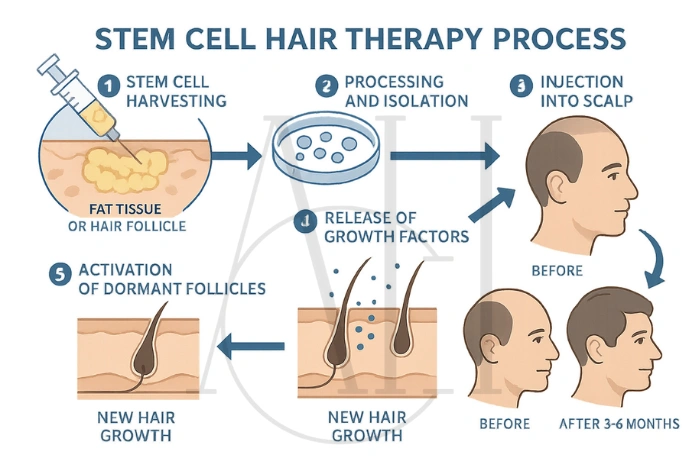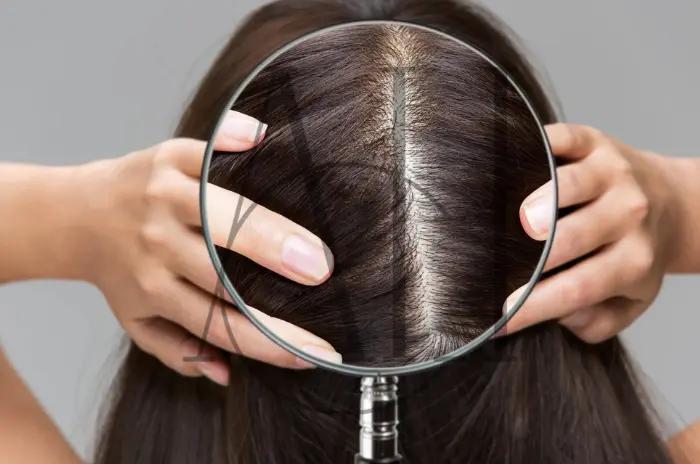Hair loss affects millions of people worldwide, creating both physical and emotional challenges. While traditional treatments have provided some relief, the emergence of stem cell therapy for hair loss represents a revolutionary approach that could transform how we address androgenetic alopecia and other forms of hair thinning. This cutting-edge treatment harnesses the regenerative power of stem cells to potentially restore hair follicles and promote natural hair regrowth.
Recent breakthroughs in regenerative medicine have opened new pathways for treating hair loss through cellular therapy. Unlike conventional treatments that simply slow hair loss, stem cell treatment aims to rejuvenate dormant hair follicles and create new ones. This innovative approach offers hope for individuals who have exhausted traditional options or seek more effective, long-lasting solutions.
Table of Contents
ToggleWhat Is Stem Cell Therapy for Hair Loss?
Stem cell therapy for hair loss involves using undifferentiated cells capable of developing into various cell types to regenerate hair follicles and promote hair growth. These remarkable cells possess the unique ability to differentiate into the specific cell types needed for hair follicle development, including dermal papilla cells, keratinocytes, and other essential components of the hair growth cycle.
The therapy typically utilizes autologous stem cells, meaning cells harvested from the patient’s own body, most commonly from adipose (fat) tissue or bone marrow. Adipose-derived stem cells hair regrowth has gained particular attention due to the relative ease of harvesting fat tissue and the high concentration of mesenchymal stem cells it contains.
How Stem Cells Help With Hair Growth
The mechanism by which stem cells promote hair growth involves multiple biological pathways that address the root causes of hair loss. Stem cells release growth factors and cytokines that stimulate dormant hair follicles, improve blood circulation to the scalp, and create an environment conducive to hair regeneration.
Treatments for hair loss using stem cells work by addressing inflammation, a key factor in androgenetic alopecia. Stem cells possess immunomodulatory properties that can reduce scalp inflammation and create optimal conditions for hair growth. They also promote angiogenesis, ensuring better nutrient delivery to hair follicles.
Exosome hair treatment represents an advanced application where extracellular vesicles derived from stem cells are used instead of the cells themselves. These exosomes contain growth factors, microRNAs, and proteins that can stimulate hair follicle regeneration without the complexity of cell transplantation.
Advanced Techniques Using Stem Cells
Current research in stem cell therapy for hair loss encompasses several sophisticated approaches. Hair cloning with stem cells represents perhaps the most ambitious technique, involving the laboratory expansion of hair follicle cells to create new follicular units that can be transplanted back to the patient.
Scientists are developing protocols for differentiating induced pluripotent stem cells (iPSCs) into hair follicle components, offering the potential for truly personalized hair restoration treatments. These best new treatments for hair loss could eventually allow for the creation of completely new hair follicles.
Stem cell exosomes for hair treatment has emerged as a promising alternative that harnesses the therapeutic benefits of stem cells without direct cell transplantation. Research suggests these vesicles can effectively stimulate hair growth through their cargo of bioactive molecules.
Safety, Risks, and Regulation
Safety of stem cell hair therapy remains a primary concern as treatments move from research laboratories to clinical applications. Autologous stem cell treatments generally present lower risks since they use the patient’s own cells, reducing the likelihood of immune rejection.
Regulatory oversight varies significantly between countries. In the United States, the FDA regulates stem cell therapies as biological products, requiring extensive clinical trials for approval. Patients should be cautious of unregulated clinics offering unproven treatments.
Stem cell hair loss clinical trials are ongoing worldwide to establish safety profiles and efficacy standards. These studies are essential for determining optimal cell types, processing methods, and treatment protocols.

Stem Cell Therapy vs. Traditional Hair Loss Treatments
| Treatment Type | Mechanism | Duration | Cost | Effectiveness |
|---|---|---|---|---|
| Stem Cell Therapy | Regenerates follicles | 6-12 months results | High initial cost | Potentially long-lasting |
| PRP Treatment | Growth factor stimulation | 3-6 months results | Moderate cost | Temporary improvement |
| Minoxidil | Vasodilation | Continuous use required | Low cost | Maintains existing hair |
| Hair Transplant | Follicle redistribution | Permanent | High cost | Permanent but limited |
| Finasteride | DHT blocking | Continuous use required | Low cost | Prevents further loss |
When comparing stem cell vs PRP for hair loss, both treatments aim to stimulate hair growth through regenerative mechanisms, but stem cells potentially offer more comprehensive regenerative capabilities. Minoxidil vs stem cell treatment represents a comparison between symptomatic and potentially curative approaches.
Traditional hair transplantation moves existing hair without increasing total follicle numbers. Stem cell approaches potentially create new follicles, offering the possibility of increasing overall hair density rather than simply redistributing existing hair.
The Process of Stem Cell Hair Treatment
The typical stem cell treatment process begins with comprehensive consultation and evaluation. Medical history and hair loss patterns are assessed to develop an appropriate treatment plan.
Cell harvesting involves liposuction to collect adipose tissue containing stem cells. This minimally invasive procedure is performed under local anesthesia. The harvested tissue is processed to isolate and concentrate stem cells.
The injection phase involves carefully administering concentrated stem cells to areas of hair loss using fine needles. The procedure typically takes several hours from harvesting to injection.
Post-treatment care involves following specific instructions to optimize healing. How to regrow hair naturally through stem cell therapy requires patience, as visible results typically appear several months after treatment.
FAQ :Advances in Stem Cell-Based Therapy for Hair Loss
What is stem cell therapy for hair?
Stem cell therapy for hair loss uses regenerative cells harvested from the patient’s own body to stimulate dormant hair follicles and potentially create new ones for natural hair regrowth.
How does this therapy promote growth?
The therapy works by releasing growth factors and cytokines that reduce inflammation, improve blood circulation, and create optimal conditions for hair follicle regeneration and cycling.
Is stem cell hair therapy safe?
When performed by qualified professionals using proper protocols, autologous stem cell treatment is generally safe, though potential risks include temporary discomfort and rare complications.
When will this treatment be available?
While some forms of stem cell hair therapy are already available through clinical trials and specialized centers, widespread availability depends on ongoing stem cell hair loss clinical trials and regulatory approvals.



